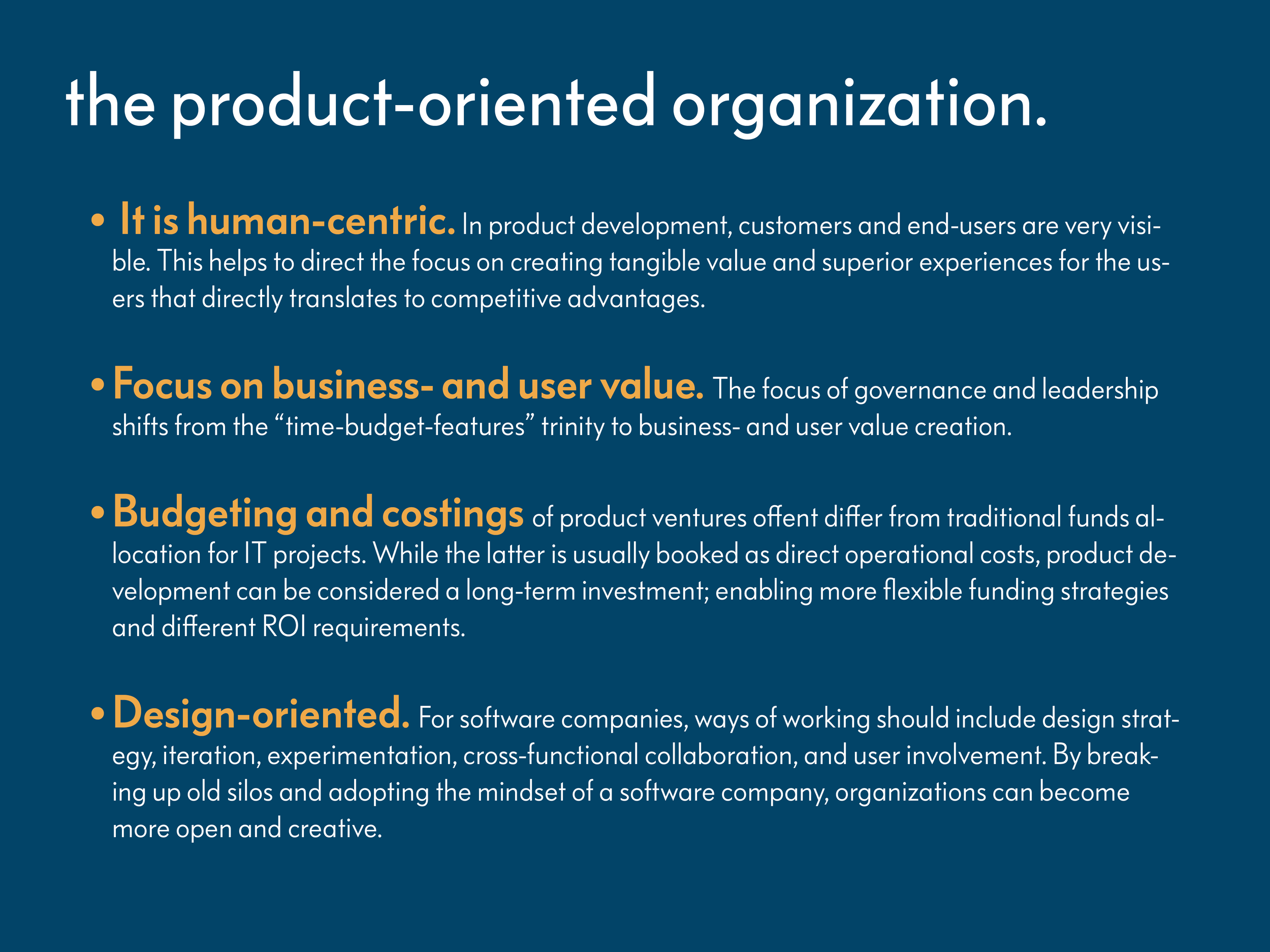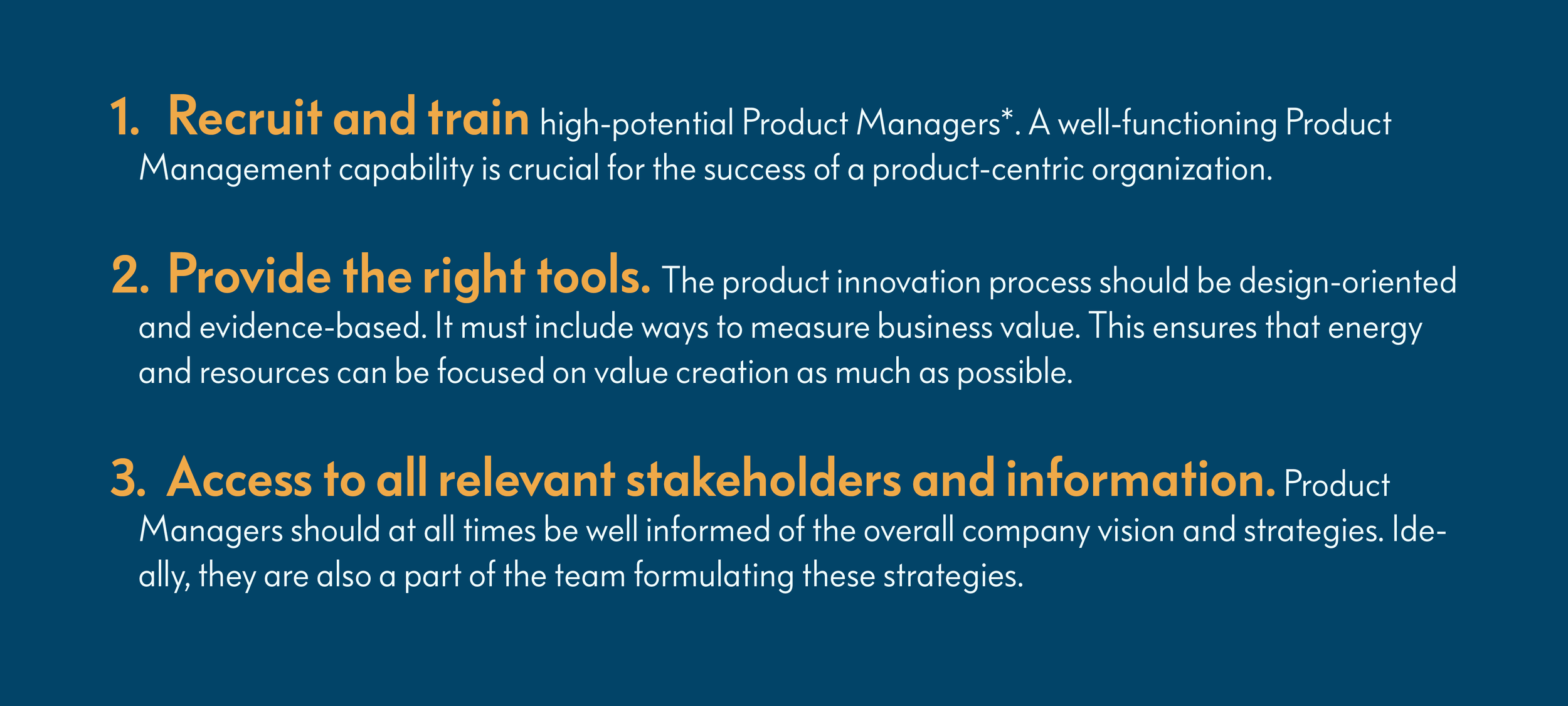(Reading time: 4 minutes)
If there is such a thing as a global business buzzword list for the last decade, ‘digital transformation’ will no doubt be in the top-10 together with ‘disruption’, ‘agile’, ‘synergy’, ‘cloud’ and ‘low-hanging fruit’. While digital transformation is a very fluffy expression which may mean nothing or everything, every organization on the planet must relate to the vast opportunities and potential threats that digital technologies present.
If you are doing it in the way that ‘IT’ has traditionally been managed, organized and operated, chances are you are not being the best you can be. Digital innovation requires new managerial practices. And a product-centric approach is often a good beginning.
As organizations adapt to digital ways of working and conducting business, the traditional role and operating model of the IT departments will need to change radically. In order to truly succeed with digital transformation and innovation, there will be no status quo; for any parts of the organization. Functional structures need to be reformatted. Hierarchical, siloed governance procedures will have to morph into new integrated and collaborative patterns.
Enterprises already on the move are therefore to an increasing extent replacing the classic project focus with product-centric operating models. This is a logical consequence of the necessary shift from a tactic- to a strategic view on digital development. Projects are task-oriented and short-term, while products can have highly strategic value and an indefinite life-span. Project-centric organizations typically operate in intermittent bursts, often with a disconnect between different initiatives. The projects are plan-driven, usually with a fixed scope and timeline while the world changes around them. In contrast, in a product-centric organization the focus is on continuous business value creation, improvement, adaptation and growth over long periods of time.
It seems rather wise for organizations not to base their long-term strategy on a set of short-term tasks. Digital products can be extremely valuable assets; and the process of aligning the organization around product development can be a vitamin injection for the whole organization as well as re-vitalizing the entire company vision.
Therefore, according to Gartner et al, as they embrace a more product-centric model, 80% of IT organizations are expected to undergo radical restructuring and changes, including mission and vision, by 2024. This is expected to create significant competitive advantages over actors with a focus on task-oriented tactics only.
Many Jayway clients have already utilized product orientation to their advantage. One example is Gleerups, a Swedish educational publisher. Combining user-centric design with agile development and analytics, Gleerups’ workflow enables a continuous evolution of their digital assets; with a focus on user-validated value. This has firmly established Gleerups as the leader in their chosen segments.
With this shift of focus, many aspects of traditional project management practices will need to be abandoned and replaced with a Product Management perspective. This change can be quite easy, or it can be painful. The degree of potential pain is both individual and industry-specific. But regardless of past performance all organizations, including the public sector, can benefit from the product paradigm. They can gain a lot of inspiration and insights from product- and service companies where digital technologies are already key enablers.
So, what signifies an organization geared towards product development?
Product Management
Structured product management is a well-established practice in both B2B and B2C product companies. A key role, arguably the most important one, in these organizations is the Product Manager. This is a role with a very broad set of responsibilities. The Product Manager is basically accountable for the success of the products in her portfolio. This includes working directly with a large number of stakeholders; e.g. business owners, R&D, marketing, sales and IT as well as customers. The Product Manager thus needs a split vision and a very broad set of skills in order to be able to align all stakeholders and ensure that the product is a viable interpretation and enabler of the business vision.
IT organizations with the ambition to adopt a product-oriented mindset have the same need as enterprises undergoing a digital transformation process with a desire to really leverage their digital assets to create business value. This also includes organizations that may already have well-established Product Management practices in their core product businesses, but still operate task-based in their IT activities.
The first steps
The journey from digital projects to products can be complex. It may have profound effects on the organizational structures, leadership, culture, and ways of working. This should be all good in the long run, but major changes still consume a lot of energy. Top management needs to be involved and committed. They must provide a strong vision and ensure careful, empathic change management.
But the good news is that this change could- and should be conducted stepwise. Design Sprints and Service Design activities, powerful tools for product development, can also be extremely useful for evolving processes and organizations.
The very first step may be to identify a good product candidate that can be leveraged as a success story. It should be important enough to have significant business potential, while at the same time being possible to launch as a minimum viable/marketable product (MVP) version within a short time frame. An MVP should not require more than 1-3 months to achieve. Any longer than that, and it needs to be partitioned.
Another very first step (yes, needs to be done in parallel) is to start sketching a Product Management function.
Enter the Product Manager
Companies that already have a Product Management function in their core product business may already have a good handle on what Product Management is about. However, in a digital product context, the Product Manager role may be different. Software development is usually conducted in shorter iterations than, say, electronics or other consumer goods manufacturing. In software, constant change and re-validation are not only necessary but desirable, which requires a faster and continuous decision process. This process is often very collaborative and requires dialog with a broad set of stakeholders on a regular basis; at a rapid pace. To a large extent, this contrasts the Product Manager role in companies with long product cycles and sequential planning- and decision processes.
An organization aspiring to a product-oriented structure needs to:



 *) Product Management is an inherently cross-functional discipline. Responsibilities can include a wide array of activities and objectives. In larger digital organizations, responsibilities for the day-to-day collaboration with the development teams are therefore often delegated to a specific Product Owner role. More about that in forthcoming posts.
*) Product Management is an inherently cross-functional discipline. Responsibilities can include a wide array of activities and objectives. In larger digital organizations, responsibilities for the day-to-day collaboration with the development teams are therefore often delegated to a specific Product Owner role. More about that in forthcoming posts.